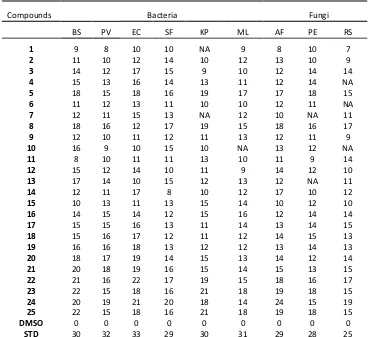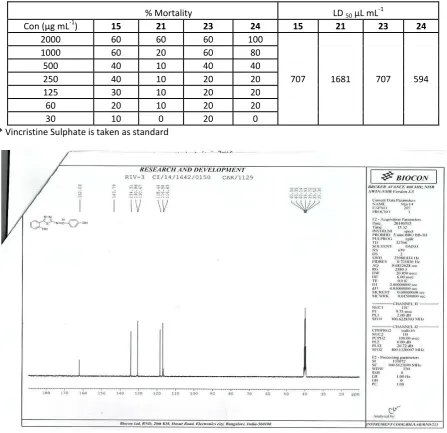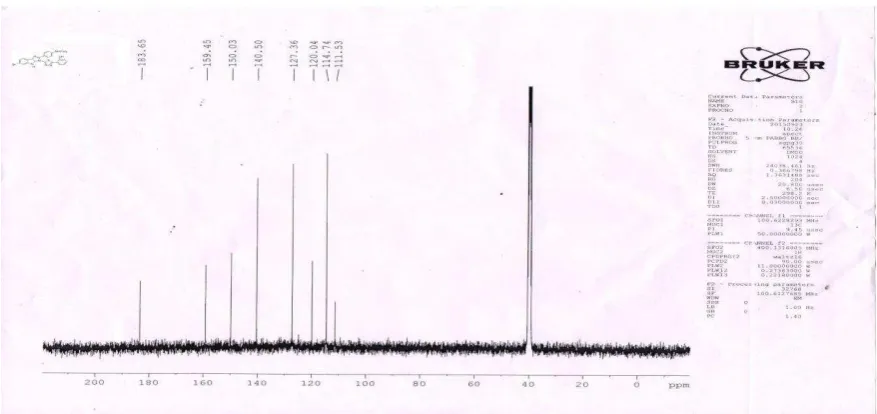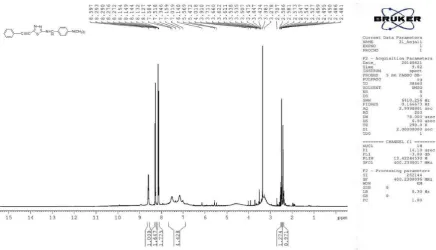Research Journal of Pharmaceutical, Biological and Chemical
Sciences
Ultrasonic Synthesis, Antimicrobial and Brine Shrimp Lethality Assay of Novel
Thiadiazole-Imidazole Derivatives
Kola Balaji, Priyanka Bhatt, and Anjali Jha*.
Department of Chemistry,GIS, GITAM University, Rushikonda, Visakhapatnam-530045, India.
ABSTRACT
A facile synthesis of 2, 5-disubstituted thiadiazole derivatives has been achieved by mixing and refluxing/ultrasonicating thiosemicarbazide with various aromatic acids in presence of only conc. sulphuric acid, which were further condensed with p-N,N-dimethyl amino / hydroxyl benzaldehyde to get imino derivatives in a sonicator. These characterized compounds were further reacted with ammonium acetate and bromo-isatin to get biological active potential thiadiazole-imidazole analogues. The structures of all newly synthesized compounds were elucidated by various spectral data. All synthesized compounds were evaluated for antimicrobial and few potential compounds were subjected to brine shrimp lethality bioassay.The detailed synthesis, spectroscopic data and activities has been reported
Keywords: thiadiazole-imidazole derivatives, antimicrobial activity, brine shrimp lethality bioassay
INTRODUCTION
The drug research is a unique multi-disciplinary process leading towards the development of novel important therapeutic agents. A wide variety of heterocyclic versatile leading molecules have been explored for designing potential bioactive agents. Among them the thiadiazole derivatives were synthesized by various methods including solvent-free conditions [1-3] and found diverse applications as pharmaceuticals, dyes and metal chelating0agents. Literature survey revealed that compounds with the thiadiazole nucleus possess antimicrobial, antituberculosis [4], anti-inflammatory, anticonvulsant [5], anti-HIV, anti-tumor[6,7] activities. Schiff bases [8,9] derived from amino thiadiazoles has also been shown to possess bacterial and anti-fungal activities. Additionally, in recent years, there has been considerable amount of progress in chemistry of imidazole [10-12] related drugs due to their high therapeutic potential and recognition as important pharmacophore in biological processes. Moreover, there is an increasing need of the development of environmentally sustainable processes for synthesis of biologically active molecules. In this context the use of ultrasonic irradiation to activate organic reactions has recently taken on a new dimension [13,14].
The microbial infections has been rapidly increasing and becoming a major threat to public health due to emergence of multidrug resistant bacteria and fungi in the past few decades. Among the various known drugs, thiadiazole derivatives [15] have emerged as an important type of heterocyclic compounds with excellent safety profile, favorable pharmacokinetic characteristics and showed wide range of potential biological applications. The synthesis of new bioactive compounds requires preliminary testing to determine the toxicity and provide important indications of the feasibility of in vivo tests. The brine shrimp (Artemia salina) is a micro crustacean used as an animal model to determine the cytotoxicity of synthetic compounds [16] and natural products [17] in lethality bioassays. The above finding and versatile chemotherapeutic uses of various heterocyclic nucleus has prompted us to do an efficient solvent less synthesis of a new class of substituted amino-thiadiazoles followed by their Schiff bases and imidazole derivatives with novel modes of action and to re-investigate the chemistry and pharmacology of alternative drugs. These new characterized biologically active compounds were evaluated for antimicrobial and cytotoxicity brine shrimp lethality assay.
RESULTS AND DISCUSSION
A large number of organic reactions can be carried out in a higher yield, shorter reaction time and milder conditions under ultrasonication [14]. In tune with green chemistry synthesis of substituted amino thiadiazole [1-5] and their imino derivatives [10-15] was accomplished according to the steps illustrated in Scheme 1 by convetional as well as by ultrasonication method. In the first step stoichiometric ratio of carboxylic acid (benzoic/salicylic/cinnamic/ phenylpropiolic/veratric) was grinded with thiosemicarbazide in mortar and pestle and then refluxed [18] in the presence of only conc. H2SO4 (conventional) and
utrasonicated for 10-15 minutes. Conc. H2SO4 was used as cyclising agent. The isolated and characterized
products (1-5) were condensed with p-N, N-dimethyl amino/hydroxy benzaldehyde to get imino derivatives under ultrasonication/conventional methods (Scheme 1). The characterized imino derivatives were further reacted with bromo-isatin in presence of ammonium acetate to get imidazole derivatives (16-25) by both the methods.TLC was run throughout the reaction to optimize the reaction for purity and completion. The isolated products from both the methods showed same melting point and spectral pattern.
Designed series of molecules (1-25) were characterized by spectral techniques before evaluating for antimicrobial and in vitro brine shrimp lethality assay. Two strong absorption bands appeared in the range between 3340 and 3200 cm-1 in the IR spectra of compounds (1–5) was attributed to primary amine [19] group of substituted thiadiazole. The other major peaks observed in the IR of these compounds are 3130–3050; 1550-1520 cm-1 could be assigned to aromatic CH and C=C of the ring. The additional peak observed in the IR of 4 at 2115 cm-1 for C C; 3 at 1623 cm-1
were attributed to CH=CH and clearly indicative of the condensation of cinnamic/ phenyl propiolic acid with thiosemicarbazide, which was further confirmed by their NMR spectra.
carbonyl peak in the 1H NMR spectra of compounds (6-15) were further supportive of condensation of amino thiadiazoles with p-N,N-dimethyl amino/hydroxy benzaldehyde. The observed signals in 13C NMR spectra of compounds (6-15 i the ra ge of δ -169 ppm are due the formation of azomethine carbon [21,22]. Further, the disappearance of C=O peak of bromo-isatin and N=CH of compound no (6-15) and presence of NH of bromo-isatin in the target compounds (16-25) indicated the reaction between them. This was also supported by their proton and carbon NMR. Other proton and carbon peaks were found to be well consistent with the expected structures.
Antimicrobial activity
A comparative study of all synthesized and characterized compounds (1-25) (MIC values showed in Table 1) indicated that all the compounds exhibited moderate to significant antimicrobial activity. The compounds 3,4,5 showed good however 10-15 increased[23] antibacterial and antifungal activity. In the case of imidazole derivatives (16-25) all compounds showed promising activity, however remarkable activities were noticed for 22-25. The increased activity of these compounds can be explained o the asis of o erto e’s concept and presence of unsaturation, bromine atom and imidazole ring. Further, the delo alizatio of π electrons over the whole ring system also enhances the lipophilicity of the compounds, which is an important factor that controls antimicrobial activity by blocking the binding sites of the enzymes of the microorganism. The weak antifungal activities observed for remaining compounds may be due to fungi were resistant to the compounds.
Table 1. Antimicrobial Activity of Synthesized Compounds at concentration 10 µg mL-1
Compounds Bacteria Fungi
Brine Shrimp Lethality Activity
The assessment of acute cytotoxicity of synthesized compounds is a pre-requisite to ensure the safety of drug like compound. Brine shrimp (Artemia salina) lethality assay in most cases correlates with cytotoxicity of the drug like compounds. After preliminary screening it was found 4, 5, 13-15,22-24 could show some significant results. However in vivo brine shrimp assay results illustrated that 15,23 and 24 have shown significant lethality of naupulii. The half maximal lethal dose (LD50) was shown in Table 2. The observed LD50
values of 15, 23 and 24 are707,707, 594 µg/ mL respectively, indicated that the compounds are not affecting the organism and even not cytotoxic at lower concentrations. However, the Vincristine sulphate (standard) showed high mortality rates in nauplii at LD50 of 28.05 µg/ mL and is considered to be highly toxic affecting the organism to the greater extent. According to structure activity relationship compound having unsaturation (24) and methoxy group at 3,4-position (15,23) are found to be highly active against brine shrimp naupulli at lower concentration also. This study can be considered to be a positive sign for synthetic compounds having different pharmacophore in a one molecule to proceed further for monitoring biological activities.
Table 2. Cytotoxicity Activity on Brine Shrimps nauplii of synthesized compounds
% Mortality LD 50μL L -1
Co μg L-1
) 15 21 23 24 15 21 23 24
2000 60 60 60 100
707 1681 707 594
1000 60 20 60 80
500 40 10 40 40
250 40 10 20 20
125 30 10 20 20
60 20 10 20 20
30 10 0 20 0
*Vincristine Sulphate is taken as standard
Figure . IR spectrum (KBr) of compound 14
Figure . IR spectrum (KBr) of compound 5
Figure 1H spectrum (400 MHz, DMSO-d6) of compound 12
Figure 1H spectrum (400 MHz, DMSO-d6) of compound 23
CONCLUSION
The objective of the present study was to do efficient synthesis and spectral characterization of some new biologically relevant thiadiazole derivatives and to explore their antimicrobial and cytotoxic activities. The results are encouraging and suggesting that target compounds thiadiazoles analogues incorporating imidazole
EXPERIMENTAL
Reagents were purchased from Across Ltd and used as it is. All the solvents were of analytical grade and were distilled before used. Melting points are uncorrected. The sonic reactions were performed in a probe sonicator of 250 W ultrasonic processor with a 12 / 20 mm probe operating at a fixed frequency of 50 Hz with speed 238 rpm. The solid IR spectra were recorded in KBr on Perkin Elmer FTIR at GITAM University, while elemental analysis was done at Micro Analytical centre at Andhra University, Visakhapatnam. The 1H and 13C NMR spectra were taken on Bruker 400 MHz NMR at Biocon Ltd, electronic city Bangalore, in DMSO-d6 using TMS as internal reference. The antimicrobial activities were done at department of Microbiology, GITAM University, however, cytotoxicity brine shrimp lethality assay was done at TRIMS Lab, MVP Colony Visakhapatnam.
Synthesis of 2-amino-5-sustituted thiadiazole (1-5)
Substituted amino thiadiazole were prepared by conventional as well as ultrasonication method as outlined in Scheme 1. A mixture of carboxylic acid (benzoic / salicylic/ cinnamic / phenyl propiolic / veratric, 0.01 mole, in separate reactions) and thiosemicarbazide (0.012 mol) were mixed thoroughly. The reaction mixture was heated under [18] reflux/ultrasonicated in the presence of only conc. H2SO4 without any solvent
for 10-12 hrs/10-15 min(US). The reaction mixture was cooled to room temperature and neutralized with ammonia solution. The solid was filtered and washed with water followed by few drops of ether. The products were recrystallized from ethanol and characterized by various spectral methods.
Scheme 1. Synthetic pathway of compounds 1-5 and 6-15
[5-phenyl-1, 3, 4-thiadiazol-2-amine] (1) White solid with yield 62% ; IR(KBr, /cm-1) :3359, 3210, 3004, 1519,1459; 1HNMR (400 MHz, DMSO-d6):7.5-7.2(m,4H),6.1-5.8(d,2H), 3.5(s,2H);
13 3105, 1627, 1520; 1HNMR(400 MHz, DMSO-d6) δ 6.7-6.9(m,3H), 4.1(s,6H),3.3(s,2H),
13
MHz,DMSO-d6) :δ56.3,113.6,115.6,120.3,129.8,145.1, 147.8,159,150; mp 184-185 °C(dec).Anal. Calcd for C10H11N3O2S: C,
50.62; H, 4.67;N, 17.71; Found: C, 50.59; H, 4.69; N, 17.75
Synthesis of 2-imino derivative of substituted thiadiazole (6-15) The characterized compounds (1-5) (0.01 mol) and p-N,N-dimethyl amino/hydroxy benzaldehyde (0.01 mol) (in separate reactions) was stirred under reflux (Scheme 1) in ethanol for 6-8 h by conventional method, however 25-35 minutes under ultrasonication. The solid product obtained from both the method was filtered off, washed with water, and recrystallized from ethanol. Identical TLC and melting point were observed for products (6-15) isolated by both the methods.
[N-(4-(dimethylamino) benzylidene)-5-phenyl-1, 3, 4-thiadiazol-2-amine] (6) Light Brown with yield 65%. IR (KBr,/cm-1) 3128, 2913-2823, 1618, 1536; 1HNMR (400 MHz, DMSO-d6) δ 8.1(s,1H), 7.6-7.9(m,4H),
6.79-[2-(5-((4-(dimethylamino) benzylidene) amino)-1, 3, 4-thiadiazol-2-yl) phenol] (8) Brown with yield 60%. IR(KBr , /cm-1)3450, 3016,1607,1519;1HNMR(400MHz DMSO-d6) δ 9.9 (s,OH);7.4-7.0(m,4H),6.9-6.7(m,4H); 2.5(s,6H);13CNMR(100 MHz,DMSO-d6) δ116,118, 130,134,158,152; mp 286-288 °C (dec)Anal. Calcd. for C17H16N4OS: C, 62.94; H, 4.97; N, 17.27; Found: C, 62.98; H, 4.92; N, 17.22.
[2-(5-((4-hydroxybenzylidene) amino)-1, 3, 4-thiadiazol-2-yl) phenol] (9) Light brown with yield 71%. IR (KBr,/cm-1)3450, 3016, 1607, 1519; 1HNMR (400 MHz, DMSO-d6) δ 9.5(s,OH),7.4-7.0 (m,4H), 6.9-6.7(m,4H), 2.48(s,6H); 13CNMR (100 MHz,DMSO-d6) δ 115, 118,130,132, 155, 152; 162.3. mp 225-228°C.Anal. Calcd. for C15H11N3O2S, for C, 60.59; H, 3.73; N, 14.13; Found: C, 60.62; H, 3.76; N, 14.18.
[N-(4-(dimethylamino) benzylidene)-5-styryl-1, 3, 4-thiadiazol-2-amine] (10) White with yield 70% IR(KBr, /cm-1)3108, 2913-2823, 1615, 1536; 1HNMR (400 MHz, DMSO-d6) δ 8.2(s,1H), 7.6-7.9(m,4H), 6.79-6.7(m,4H),6.1-5.9(d,2H), 2.69(s,6H) ;13CNMR(100 MHz,DMSO-d6) δ 38.2, 111.4, 112.6, 125, 132, 153.6,156,165.3. mp 264-265°C(dec). Anal. Calcd. for C19H18N4S: C, 68.23; H, 5.42; N, 16.75; Found: C, 68.26; H, 5.47; N, 16.78.
[4-(((5-styryl-1,3,4-thiadiazol-2-yl)imino)methyl)phenol] (11) White with yield 65%;IR(KBr , /cm-1)3108, 2913-2823,1615,1536;1HNMR (400 MHz, DMSO-d6) δ 9.5, 8.0, 7.6-7.9(m,4H), 6.79-6.7(m,5H), 6.0-5.9(d,2H) ;
13
CNMR (100 MHz, DMSO-d6) δ 112.4, 114.6, 125, 132, 153.6, 156, 161.3. mp 243-245°C(dec). Anal. Calcd. for C17H13N3OS:C, 66.43; H, 4.26; N, 13.67; Found: C, 66.40; H, 4.31; N, 13.71.
[N-(4-(dimethylamino) benzylidene)-5-(phenylethynyl)-1, 3, 4-thiadiazol-2-amine] (12) Brown with yield 72%: IR(KBr ,/cm-1 )3110, 2105, 1618, 1519;1HNMR (400 MHz, DMSO-d6) δ 8.1(s,1H), 7.5-7.9(m,5H), 6.9-6.7(m,5H), , 2.8(s,6H) ; 13CNMR(100 MHz, DMSO-d6) δ 86,77, 126, 128, 129, 130, 157.7, 152.5; 162.3. mp 217-220°C(dec). Anal. Calcd. for C19H16N4S: C, 68.65; H, 4.85; N, 16.85; Found: C, 68.69; H,4.81; N, 16.81.
[4-(((5-(phenylethynyl)-1, 3, 4-thiadiazol-2-yl) imino) methyl) phenol](13) Brown with yield 64% ; IR(KBr, / cm-1)3405,3104,2108,1620,1519;1HNMR(400 MHz, DMSO-d6) δ 9.6(s,1H), 8.2(s,1H), 7.8-7.2(m,7H), 6.9-6.7(m,5H) 13CNMR (100 MHz,DMSO-d6) δ 86,77,126,128,129,130,157.7, 152.5, 160.2; mp 210-212°C (dec)Anal. Calcd.for C17H11N3OS: C,66.87; H, 3.63; N, 3.76; Found: C, 66.90; H, 3.68; N, 13.80.
[5-(3, 4-dimethoxyphenyl)-N-(4-(dimethylamino) benzylidene)-1,3,4-thiadiazol-2-amine] (14) Light yellow with yield 59% ; IR(KBr, / cm-1) 3105,1612, 1520; 1HNMR(400 MHz, DMSO-d6) δ 8.1(s,1H);7.7-7.3(m,7H), 6.8-6.5(m,5H),3.8(s,6H),2.5(s,6H) 13CNMR(100 MHz, DMSO-d6) δ 55.3, 113.6, 115.6, 120.3, 129.8, 159, 150, 62.2; mp 192-194°C (dec) .Analysis: Calcd. for C19H20N4O2S: C, 61.94; H, 5.47; N, 15.21; Found: C, 61.98; H, 5.42; N,
[4-(((5-(3, 4-dimethoxyphenyl)-1, 3, 4-thiadiazol-2-yl) imino) methyl) phenol](15) Light yellow with yield 58%; IR(KBr, / cm-1) 3406,3105,1615,1520;1HNMR (400 MHz, DMSO-d6) δ 9.6(s,OH), 7.8-7.3(m,7H), 6.9-6.5(m,4H), 3.7(s,6H), 13CNMR(100 MHz, DMSO-d6) δ 56.3,113.6,115.6,120.3, 129.8, 135.1,159,150; mp 174-176°C(dec). Anal. Calcd. for C17H15N3O3S: C, 59.81; H, 4.43; N, 12.31; Found: C,59.85; H, 4.48; N, 12.35.
Synthesis of imidazole derivatives of substituted thiadiazole Schiff bases (16-25) An equimolar amounts of a o e hara terized S hiff’s ase (6-15) (0.01 mole, 10 mL methanol) and bromo-isatin (0.01 mole, 10 mL methanol) were charged along with excess of ammonium acetate (2 mole) in to a round bottom flask. The mixture was refluxed (Scheme 2) for about 4-6 hrs in conventional methods. While the same ratio of reagents were taken in a conical flask and ultrasonicated for 20-30 minutes. The reaction mixture were kept in refrigerator for overnight, then filtered, washed with water to remove excess ammonium acetate and dried.
Scheme 2. Synthetic pathway of compounds 16-25
[4-(6-bromo-3-(5-phenyl-1,3,4-thiadiazol-2-yl)-3,4-dihydroimidazo[4,5-b]indol-2-yl)-N,N-dimethylaniline] (16) Light orange with yield 62% IR(KBr, / cm-1) 3128, 2913-2823, 1536; 1HNMR (400 MHz,DMSO-d6) δ 7.9(s,1NH),7.6-7.2(m,7H),6.9-6.7(m,4H) 2.7(s,6H); 13CNMR(100 MHz, DMSO-d6)δ39.2,111.4,125, 132, 154.6, 159. mp 240-242°C (dec). Anal. Calcd.for C25H19BrN6S: C, 58.26;H, 3.72; N, 16.30; Found: C, 58.29; H, 3.725; N, 16.27
[4-(6-bromo-3-(5-phenyl-1,3,4-thiadiazol-2-yl)-3,4-dihydroimidazo[4,5-b]indol-2-yl)phenol] (17) Light red with yield 68%; IR (KBr, / cm-1) 3460,3128,2913-2823,1536: 1HNMR (400 MHz, DMSO-d6) δ (.29s,1OH),7.9(s,1NH) 7.6-7.4(m,7H),6.8-6.5(m,4H); 13CNMR(100 MHz, DMSO-d6) δ 111.4, 125, 132, 154.6, 159, 165.3; mp 232-235°C (dec).Anal. Calcd. for C23H14BrN5OS:C, 56.57; H, 2.89; N, 14.34; Found: C,56.52; H, 2.84;
N, 14.39
[2-(5-(6-bromo-2-(4-(dimethylamino)phenyl)imidazo[4,5-b]indol-3(4H)-yl)-1,3,4-thiadiazol-2-yl)phenol] (18)
Light brown with yield 71%;IR(KBr, / cm-1) 3450, 3016, 1519; 1HNMR (400 MHz, DMSO-d6) δ 9.7(s,OH),8 .0(s,1NH), 7.6-7.3(m,7H),6.6-6.4(m,4H), 2.6(s,6H); 13CNMR(100 MHz, DMSO-d6)δ 116 ,118 ,130 ,134 ,158 ,152 .mp 248-250°C (dec). Anal .Calcd. for C25H19BrN6OS :C,56.50;H,3.60;N,15.81; Found C, 56.53; H, 3.65; N, 15.75
[2-(5-(6-bromo-2-(4-hydroxyphenyl)imidazo[4,5-b]indol-3(4H)-yl)-1,3,4-thiadiazol-2-yl)phenol] (19) Light brown with yield 70% mp 235-237°C; IR (KBr, / cm-1)3450,3016,1519; 1HNMR (400 MHz, DMSO-d6) δ 8.0(s,1NH). 7.8-7.5(m,7H),6.9-6.5(m,4H); 13CNMR (100 MHz, DMSO-d6) δ 115, 118, 130, 132, 155, 152. mp 235-237°C (dec). Anal. Calcd.for C23H14BrN5O2S:C, 54.77; H, 2.80; N, 13.89; Found: C, 54.79; H, 2.75; N, 13.86
[4-(6-bromo-3-(5-styryl-1,3,4-thiadiazol-2-yl)-3,4-dihydroimidazo[4,5-b]indol-2-yl)-N,N-dimethylaniline] (20)
Light orange with yield 56%; IR (KBr, / cm-1) 3108,2913-2823,1536; 1HNMR (400 MHz, DMSO-d6) δ 9.2(s,OH), 8.0(s,1NH). 7.8-7.6(m,7H),6.8-6.5(m,4H), 6.0-5.9(d,2H); 13CNMR (100 MHz, DMSO-d6) δ 38.2,111.4, 112.6, 125, 132, 153.6, 156; mp 290-292°C (dec) Anal. Calcd. for C27H21BrN6S: C, 59.89; H, 3.91; N,15.52; Found: C, 59.84;
H,3.97; N, 15.48
[4-(6-bromo-3-(5-styryl-1,3,4-thiadiazol-2-yl)-3,4-dihydroimidazo[4,5-b]indol-2-yl)phenol] (21) Light brown with yield 59% IR (KBr, / cm-1)3108,2913-2823,1536;1HNMR (400 MHz, DMSO-d6 δ : . s, OH , . s, NH , 7.8-7.6(m,7H),6.9-6.7(m,4H) 6.1-5.9(d,2H);13CNMR(100 MHz, DMSO-d6)δ 112.4,114.6,125,132,153.6,156.mp 285-287°C (dec) Anal. Calcd.for C25H16BrN5OS: C, 58.37; H, 3.14; N, 13.61; Found: C, 58.32; H, 3.20; N, 13.66
DMSO-d6) δ 7.9(s,1NH), 7.7-7.6(m,7H),6.9-6.7(m,4H),2.5(s,6H), 130,157.7, 152.5. mp 242-245°C(dec).Anal. Calcd. for C25H14BrN5OS:C, 58.60; H, 2.75; N,13.67; Found:C,58.67;
H,2.79; N, 13.69
[4-(6-bromo-3-(5-(3,4-dimethoxyphenyl)-1,3,4-thiadiazol-2-yl)-3,4-dihydroimidazo[4,5-b]indol-2-yl)-N,N-dimethylaniline] (24) Light orange with yield 70%IR (KBr, / cm-1)3105, 1520; 1HNMR (400 MHz, DMSO-d6) δ 7.8(s,1NH), 7.6-7.2(m,7H),6.9-6.7(m,4H),4.1(s,6H), 2.7(s,6H), 13CNMR(100 MHz, DMSO-d6)δ 55.3, 113.6, 115.6, 120.3, 129.8,159, 150; mp 277-280°C(dec); Anal. Calcd. for C27H23BrN6O2S: C, 56.35; H, 4.03; N, 14.60; Found: Bacillus subtilis, PV-Pseudomonas vulgaris, EC-Escherichia coli, SF-Streptococcus faecalis, KP-Klebsilia pneuomonia, ML-Micrococcus luteus] and three fungi [AF-Aspergillus flavus, PE-Pencillian expasom, RS-Rhizoctonia solani] using the well diffusion method. The whole procedure was carried out as reported by us earlier [23]. The results are shown in Table 1.
Brine Shrimp Lethality Assay
The Brine shrimp assay was used for screening toxicity of bioactive compounds. Brine shrimp assay is an affordable and viable alternative to mouse bioassay with ethical constraints [17]. Brine shrimp lethality bioassay was carried out to investigate the cytotoxicity of newly synthesized and characterized thiadiazole derivatives. Brine shrimp (Artemia salina) eggs were collected from hatcheries and left under constant aeration for 48 hrs in a conical flask (1L) filled with sterile artificial sea water and the eggs were then allowed to hatch. After the hatching of eggs, the active nauplii were free from egg shells, then collected from a brighter portion of the hatching chamber and were used for the assay. Ten nauplii were drawn through a glass capillary and placed in vials containing 9 mL of the brine solution each. In each vial, 1 mL of the test compounds (1 to 25 and standard) were added to 9 mL of brine solution and retained at room temperature for 24 hours under the light. The surviving larvae were counted to calculate LD50 of all test compounds. The experiments were
conducted with different concentrations (1.562-1600 µg mL-1) of test compounds according to OECD test guidelines along with standard control. The experiment was repeated thrice and the percent of mortality (LD50)
determined using the
Equation----
Where, M is the mortality of individuals in time t (%), N is the average number of dead individuals; N0
is the initial number of living individuals set in individual concentration.
ACKNOWLEDGEMENTS
for doing Brine Shrimp Lethality assay and antimicrobial activities respectively. Authors are also thankful to Biocon Ltd, electronic city Bangalore and Andhra University for spectral studies.
REFERENCES
[1] A. S.Shahvelayati, I.Yavari, A. S.Delbari, Chin. Chem. Lett., 2014;25:119-122.
[2] I. H. R.Tomi, A.H.R.Al-Daraji, R.R.T.Al-Qaysi, M. M. Hasson, K. H. D.Al-Dulaimy Arabian J. of Chem., 2014; 7: 687-694.
[3] S.Yuvaraj, M. Mendon,A. Almeida,M. Dhiman,M. Girish, Med. Chem. Res., 2014; 23:2667-2675.
[4] C. G. Oliveira, P. I. da S. Maia,M. Miyata, F. R. Pavan, C.Q. F. Leite, E. T. de Almeidad, V.M.Deflon, J. Braz. Chem. Soc., 2014;25:1848-1856.
[5] N.Siddiqui,A.Rana, S.A.Khan, S.E. Haque, M.F. Arshad,S.Ahmed,W.Ahsan,Acta Pharma,2009;59: 441-451.
[6] A. Velidandi, K. K. Gadidasu, S. V. Patri, RJPBCS, 2015; 6(4): 404-418
[7] V. Padmavathi, G .S. Reddy, A. Padmaja, P.Kondaiah, Ali-Shazia, Eur. J. Med.Chem., 2009;44: 2106-2112.
[8] P. G. More, N. N.Karale, A. S. Lawand,N. Narang,R.H. Pati, Med. Chem.Res., 2014;23:790. [9] M. Tuncel,S. Serin, Transition Met. Chem., 2006; 31:805-812.
[10] P.Marchand, M. L.Borgne,M. Palzer, G. L.Baut,R.W.Hartmann, Bioorg. Medicinal Chem. Lett., 2003;13:1553-1555.
[11] A.Barakat, A. M.Al-Majid, F.M. Al-Qahatany, M.S.Islam,M.H.M.Al-Agamy, Bull. Korean Chem. Soc., 2014;35(2):563-569.
[12] A. H. Alsryfy, Z. A. Mosaa, N. Alrazzak, RJPBCS, 2015; 6(2): 798-802. [13] E.M.Hussein,K.S.Khairou, Synth.Commun., 2014;44: 2155-2191.
[14] L. Pizzuti, P.L.G. Martins, B.A. Ribeiro, F.H. Quina,E. Pinto, A.F.C.Flores, D. Venzke, C.M.P.Pereira, Ultrasonics Sonochemistry, 2010;17:34-37.
[15] R.El-Sayed,A. Shaldom, L.Al. Mazrouee ,Synth.Commun., 2015;45:886-897.
[16] S.Nazir,F.L.Ansari,T.Hussain,K.Mazhar,A.G.Muazzam,Zaheer-ul-Haq,T.Q.Makhmoor, H.Noureen,B.Mirza, Pharm Biol.,2013;51:1091-1103.
[17] B.N.Meyer, N.R. Ferringni, J. E. Putnam, L.B.Jacobsen, D.E. Nichols, J. L. Mclaughlin, Planta Medica, 1982;45:31-34.
[18] V.K.Pandey, H.S.Negi, M.N.Joshi, S.K.Bajpai, Indian J Chem., 2003;42B:206-210. [19] V.V.Dabholkar,F.Y. Acta Poloniae Pharmaceutica-Drug Research, 2008;65(5): 521-526.
[20] N.Rezki, A.M.Al-Yahyawi, S.K. Bardaweel, F.F. Al-Blewi, M.R. Aouad,Molecules,2015;20:16048-67 [21] Y.M. Issa, H. B. Hassib, H. E. Abdelaal, Spectrochimica Acta.,2009; 74: 902-910.



